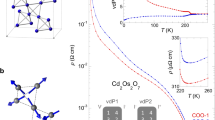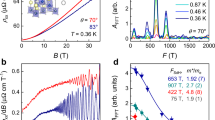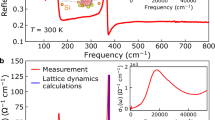Abstract
The metal–insulator transition (MIT) is a hallmark of strong correlation in solids1,2,3. Quantum MITs at zero temperature have been observed in various systems tuned by either carrier doping or bandwidth1. However, such transitions have rarely been induced by application of magnetic field, as normally the field scale is too small in comparison with the charge gap, whose size is a fraction of the Coulomb repulsion energy (∼1 eV). Here we report the discovery of a quantum MIT tuned by a field of ∼10 T, whose magnetoresistance exceeds 60,000%. In particular, our anisotropic magnetotransport measurements on the cubic insulator Nd2Ir2O7 (ref. 4) reveal that the insulating state can be suppressed by such a field to a zero-temperature quantum MIT, but only for fields near the [001] axis. The strong sensitivity to the field direction is remarkable for a cubic crystal, as is the fact that the MIT can be driven by such a small magnetic field, given the 45 meV gap energy5, which is of order of 50 times the Zeeman energy for an Ir4+ spin. The systematic change in the MIT from continuous near zero field to first order under fields indicates the existence of a tricritical point proximate to the quantum MIT. We argue that these phenomena imply both strong correlation effects on the Ir electrons and an active role for the Nd spins.
This is a preview of subscription content, access via your institution
Access options
Subscribe to this journal
Receive 12 print issues and online access
$259.00 per year
only $21.58 per issue
Buy this article
- Purchase on SpringerLink
- Instant access to full article PDF
Prices may be subject to local taxes which are calculated during checkout




Similar content being viewed by others
References
Imada, M., Fujimori, A. & Tokura, Y. Metal–insulator transition. Rev. Mod. Phys. 70, 1039–1263 (1998).
Kuwahara, H., Tomioka, Y., Asamitsu, A., Moritomo, Y. & Tokura, Y. A first-order phase transition induced by a magnetic field. Science 270, 961–963 (1995).
Ramirez, A. P. Colossal magnetoresistance. J. Phys. Condens. Matter 9, 8171–8199 (2000).
Matsuhira, K., Wakeshima, M., Hinatsu, Y. & Takagi, S. Metal–insulator transition in pyrochlore oxides Ln2Ir2O7 . J. Phys. Soc. Jpn 80, 094701 (2011).
Ueda, K. et al. Variation of charge dynamics in the course of metal–insulator transition for pyrochlore-type Nd2Ir2O7 . Phys. Rev. Lett. 109, 136402 (2012).
Nakatsuji, S. et al. Metalic Spin-liquid behavior of the geometrically frustrated Kondo lattice Pr2Ir2O7 . Phys. Rev. Lett. 96, 087204 (2006).
Machida, Y., Nakatsuj, S., Onoda, S., Tayama, T. & Sakakibara, T. Time-reversal symmetry breaking and spontaneous Hall effect without magnetic dipole order. Nature 463, 210–213 (2010).
Tokiwa, Y., Ishikawa, J. J., Nakatsuji, S. & Gegenwart, P. Quantum criticality in a metallic spin liquid. Nature Mater. 13, 356–359 (2014).
Sagayama, H. et al. Determination of long-range all-in-all-out ordering of Ir4+ moments in a pyrochlore iridate Eu2Ir2O7 by resonant X-ray diffraction. Phys. Rev. B 87, 100403 (2013).
Wan, X., Turner, A. M., Vishwanath, A. & Savrasov, S. Y. Topological semimetal and Fermi-arc surface states in the electronic structure of pyrochlore iridates. Phys. Rev. B 83, 205201 (2011).
Pesin, D. & Balents, L. Mott physics and band topology in materials with strong spin–orbit interaction. Nature Phys. 6, 376–381 (2010).
Witczak-Krempa, W. & Kim, Y. B. Topological and magnetic phases of interacting electrons in the pyrochlore iridates. Phys. Rev. B 85, 045124 (2012).
Yang, B. J. & Nagaosa, N. Emergent topological phenomena in thin films of pyrochlore iridates. Phys. Rev. Lett. 112, 246402 (2014).
Witczak-Krempa, W., Go, A. & Kim, Y. B. Pyrochlore electrons under pressure, heat, and field: Shedding light on the iridates. Phys. Rev. B 87, 155101 (2013).
Tomiyasu, K. et al. Emergence of magnetic long-range order in frustrated pyrochlore Nd2Ir2O7 with metal–insulator transition. J. Phys. Soc. Jpn 81, 034709 (2012).
Witczak-Krempa, W., Chen, G., Kim, Y. B. & Balents, L. Correlated quantum phenomena in the strong spin–orbit regime. Annu. Rev. Condens. Matter Phys. 5, 57–82 (2014).
Shapiro, M. C. et al. Structure and magnetic properties of the pyrochlore iridate Y2Ir2O7 . Phys. Rev B 85, 214434 (2012).
Sakakibara, T., Tayama, T., Hiroi, Z., Matsuhira, K. & Takagi, S. Observation of a Liquid-gas-type transition in the pyrochlore spin ice compound Dy2Ti2O7 in a magnetic field. Phys. Rev. Lett. 90, 207205 (2003).
Kondo, T. et al. Quadratic Fermi Node in a 3D strongly correlated semimetal. Preprint at http://arXiv.org/abs/1510.07977 (2015).
Zhang, H., Haule, K. & Vanderbilt, D. Metal–insulator transition and topological properties of pyrochlore iridates. Preprint at http://arXiv.org/abs/1505.01203 (2015).
Shinaoka, H., Shintaro, H., Troyer, M. & Werner, P. Phase diagram of pyrochlore iridates: All-in/all-out magnetic ordering and non-Fermi liquid properties. Phys. Rev. Lett. 115, 156401 (2015).
Savary, L., Moon, E. G. & Balents, L. New Type of quantum criticality in the pyrochlore iridates. Phys. Rev X 4, 041027 (2014).
Arima, T. Time-Reversal symmetry breaking and consequent physical responses induced by all-in-all-out type magnetic order on the pyrochlore lattice. J. Phys. Soc. Jpn 82, 013705 (2013).
Yamaji, Y. & Imada, M. Metallic interface emerging at magnetic domain wall of antiferromagnetic insulator: Fate of extinct Weyl electrons. Phys. Rev. X 4, 021035 (2014).
Brando, M., Belitz, D., Grosche, F. M. & Kirkpatrick, T. R. Metallic quantum ferromagnets. Preprint at http://arXiv.org/abs/1502.02898 (2015).
Ueda, K. et al. Magnetic field-induced Insulator-semimetal transition in a pyrochlore Nd2Ir2O7 . Phys. Rev. Lett. 115, 056402 (2015).
Millican, J. N. et al. Crystal growth and structure of R2Ir2O7 (R = Pr, Eu) using molten KF. Mater. Res. Bull. 42, 928–934 (2007).
Ishikawa, J. J., O’Farrell, E. C. T. & Nakatsuji, S. Continuous transition between antiferromagnetic insulator and paramagnetic metal in the pyrochlore iridate Eu2Ir2O7 . Phys. Rev. B 85, 245109 (2012).
Acknowledgements
We thank A. Matsuo for technical assistance, and K. Behnia and A. Nevidomskyy for useful discussions. This work has been supported in part by Grants-in-Aid for Scientific Research (No. 25707030), Program for Advancing Strategic International Networks to Accelerate the Circulation of Talented Researchers (No. R2604) from the Japanese Society for the Promotion of Science and PRESTO of JST, and Grant-in-Aid for Scientific Research on Innovative Areas (15H05882, 15H05883). L.B. was supported by the DOE Office of Basic Energy Sciences, DE-FG02-08ER46524. H.I. was supported by JSPS Postdoctoral Fellowships for Research Abroad. T.H.H. was supported by a KITP Graduate Fellowship and DOE Office of Basic Energy Sciences, DE-SC0010526.
Author information
Authors and Affiliations
Contributions
S.N. planned the experimental project. Z.T., J.J.I. and S.N. prepared single crystals. Z.T., Y.K., T.T. and K.K. performed high-field measurements. L.B. planned the theoretical project. H.I., T.H.H. and L.B. performed theoretical calculations. Z.T., T.T., L.B. and S.N. wrote the paper. T.H.H. and H.I. wrote the theory in the Supplementary Information. All authors discussed the results and commented on the manuscript.
Corresponding authors
Ethics declarations
Competing interests
The authors declare no competing financial interests.
Supplementary information
Supplementary information
Supplementary information (PDF 2665 kb)
Rights and permissions
About this article
Cite this article
Tian, Z., Kohama, Y., Tomita, T. et al. Field-induced quantum metal–insulator transition in the pyrochlore iridate Nd2Ir2O7. Nature Phys 12, 134–138 (2016). https://doi.org/10.1038/nphys3567
Received:
Accepted:
Published:
Issue date:
DOI: https://doi.org/10.1038/nphys3567
This article is cited by
-
Magnetotransport of Sm2Ir2O7 across the pressure-induced quantum-critical phase boundary
npj Quantum Materials (2024)
-
Quantum transport in topological semimetals under magnetic fields (III)
Frontiers of Physics (2023)
-
Higher harmonics in planar Hall effect induced by cluster magnetic multipoles
Nature Communications (2022)
-
Progress and prospects in magnetic topological materials
Nature (2022)
-
Magnetic monopole density and antiferromagnetic domain control in spin-ice iridates
Nature Communications (2022)



